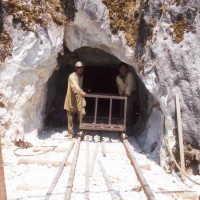Mogok City, the mines & the rubies

Some two hundred kilometres north-east of Mandalay in Myanmar lays Mogok, for centuries the ruby capital of the world. It is by no means a simple place to reach. What would take less than 2 hours by car, on well paved country roads, easily takes 7 hours of exhausting driving. For foreigners it is further complicated. Except for some rare government organized group tours, foreigners are not allowed into Mogok at all. Military roadblocks along the way ensure nobody tries their luck.
It is not known exactly how many people live in this hilly city 1,500 meters above sea level. Some say 300,000 people, others 500,000. What is certain is that the inhabitants earn their living from rubies and other gemstones. The first rubies were probably discovered in the Stone Age by villagers in the area.
Rubies have been embedded in marble (crystalline limestone) in Mogok for millions of years. Over time, the fierce Burmese Monsoons have gradually loosened the rubies from their marble nests and carried them down from the surrounding hills into the Mogok valley. The heavy stones have settled at the bottom of the many streams in and around the city. These river beds have traditionally been the source of most of the rubies.
Over the Centuries the river sediment has grown thick with heavy mud and gravel. To reach the rubies, shafts had to be excavated, some many hundreds of meters deep. Gravel was brought to the surface in rattan baskets by means of primitive cords and winches, then panned for these precious gemstones in the river streams.
Mining in Mogok today takes several forms, all still based on intensive use of manual labor. As the river floors are mostly exhausted, mining is now concentrated on hill side deposits. It may be through open casts or trenches, deep pits, or through excavating tunnels directly into the limestone.
During the Bagan dynasty, nearly 1000 years ago, rubies were worn by the Burmese royalty. When European explorers discovered Burma they brought the gemstones back where they were sought after by the aristocracy and the well-to-do.
Later the Mogok ruby tracts became a royal monopoly. Valuable gemstones mined were considered Crown property.
After the British annexation of upper Burma in the late 19th Century the ruby concession in Mogok was awarded to the London based company, Burma Ruby Mines Ltd., which held a monopoly until well into the 1930’s. After Burma’s independence, in 1948, the mines were nationalized and are now to, a large extent, controlled by the government.



I have been there, it is tourist must! I have great memories from this place…
yes i have a dream to visit but let the myanmar people be settled.